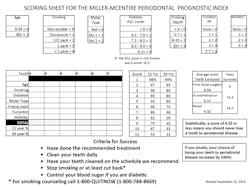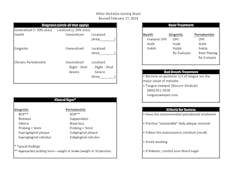Periodontal Therapy: Substance, not Sizzle
BY LYNNE SLIM, RDH, BSDH, MSDH
I always recognize a talented oral health-care professional who piques my interest, and Dr. P.D. Miller, a professor and periodontist, is no exception. He pokes fun at himself just as Joan Rivers used to do, and I usually find it a sign of a positive, upbeat personality.
Dr. Miller's credentials are impeccable, and he has served as president of the American Academy of Periodontology. He has received both of the AAP's highest awards, the Master Clinician Award and Gold Medal. Dr. Miller refers to the general dentist as a restorative dentist and the dental hygienist as an oral health-care professional who is performing procedures that used to be reserved for the conventional periodontist.
General dentists are not referring to periodontists the way they used to, and practicing periodontists have instead added implants and periodontal plastic surgery to their specialty. In addition, he believes the RDH is well qualified to conduct a periodontal assessment, and he recognizes the difference in clock hours in the area of periodontics in accredited educational programs between an RDH and a dentist. Dentists only receive 295 clock hours compared to 2,700 clock hours for the RDH, and 5,560 clock hours for the periodontal specialist.1
Having practiced for 43 years and now teaching part-time at the College of Dental Medicine at the Medical College of South Carolina, Dr. Miller took notice of the number of salvageable teeth being extracted by dental students and decided it was time to develop a simple scoring index to determine the prognosis of periodontally-involved molar teeth. I briefly introduced the index in a column a couple of months ago, but I now want to show you how it works.
--------------------------------------
Other articles by Lynne Slim
- Hype vs. Evidence: Revisiting research regarding oral/systemic disease
- Keep on perio charting dental patients
- Wave Goodbye to floss? What is the evidence behind telling perio patients to floss?
--------------------------------------
The Miller-McEntire Periodontal Prognosis Index is simple, statistically validated, and a valuable tool an RDH can add to her assessment toolbox. Dr. Miller continues to test the accuracy of the index in the Charleston dental school where he teaches, and he has also developed a website (cureyourgumdisease.com) that shows you how to apply the index in a clinical setting.
With the high prevalence of chronic periodontitis in adults, scoring the prognosis of molars with periodontal disease makes sense. After using the scoring system clinically for over two years, Dr. Miller found many benefits for patients. Patients don't always understand the significance of probing depths, furcation involvement, bleeding, mobility and bone loss no matter how you present it, and it's time consuming to do a thorough assessment.
This does not mean it's not necessary to perform a comprehensive exam. Explaining exam results to a patient is difficult, though, and even the best chairside communicator sometimes falls flat on her face in attempting to explain the disease. Tooth prognosis is rarely mentioned, except by a periodontal specialist. We don't seem to pay attention to periodontal prognosis, but we rush the periodontal exam with a focus on probing depths only and immediately schedule scaling and root planing (SRP) appointments.
SRP is now seen as profit center for a dental practice and the predominant focus seems to be on profitability instead of what's best for the patient long term.
Instead of scoring all molars with moderate to severe periodontis, scoring only one molar is less time consuming and seems to create a greater motivational impact. Scoring the most severely involved molar is what Dr. Miller recommends. Over time, routine scoring can be calculated mentally with a high degree of accuracy and predictability.
Scoring the Miller-McEntire Index
Learning how to score the index takes up very little chair time, and it's incredibly easy to compute. On the website (cureyourgumdisease.com), click on, "I am a Hygienist" under registration. Next, click on the link, "Hints on Simplified Scoring." When the score is converted to a percentage of success (see Figure I), it can be motivational for the patient, maybe even smokers.
If you are able to tell the patient, for example, "If you follow my recommendations, you have a 93% chance of keeping your teeth for 15 years," it gives the patient something to think about.
Score one tooth only - Score the most severely involved tooth, and Dr. Miller finds the maxillary second molar is typically the molar indicated for scoring. With a typical diagnosis of moderate to severe periodontitis, and giving a score with recommendations for success, an important role of the RDH is to make sure the patient understands and adheres to maintenance recall interval.
As most RDHs know, this isn't easy because so many adult patients are insurance-driven. Referral to a periodontist makes this easier sometimes, especially if the patient complies with your recommendations for referral. Remember that smoking is even more detrimental to progress than we may realize, and teeth with furcations can have a very favorable prognosis. Young patients with severe disease can have a very favorable prognosis, too, if they follow Miller's criteria for success.
Scoring mobility, furcations, and smoking isn't easy for hygienists or dentists, so Dr. Miller offers some assistance, especially when adding a numeric value to the total index score.
Furcations - If you are uncertain about whether or not a furcation is involved, Dr. Miller suggests scoring it as a furcation. He says it's better to err on the side of over scoring than under scoring. Any probing depth greater than 7 mm interproximally on maxillary molars or 5 mm on facial or lingual furcations should be scored as furcations.
Mobility- Mobility is based on your clinical opinion. Do you think the mobility is impacting the prognosis? For example, two mandibular second premolars may have the same degree of mobility. One is on a 40 year-old patient and will be used as an abutment for a removable partial denture while the other is found on a 75 year-old with no missing teeth. In the first case, the premolar mobility score would be 2 while in the second case the score would be 1.
Smoking - Given that smokers tend to underestimate the amount they smoke when questioned, let the patient determine the numeric score for smoking. This patient participation may be one key in successful smoking cessation efforts. Finally, let the patient add up all scores and determine their percentage of success for 15 years. It then becomes obvious why smoking cessation is so important.
Generally, when the patient is told that the likelihood of their losing their teeth increases by 246% when compared to a nonsmoker, they may be more willing to, as Dr. Miller says, "seal the deal."
Dr. Miller's website is chock full of practical links and useful information for patient education. One link, in particular, that I want to write about in the future is the importance of tongue cleaning. If you click on the dental student section, you will also find a Powerpoint presentation that includes additional information on the Miller-McEntire index, and I strongly recommend studying these slides.
P.D. Miller is adamant that he is selling "substance, not sizzle," and he emphasizes this point in one of his student Powerpoint slides. He clearly recognizes that scientific evidence trumps clinical experience and he continues to work hard to collect data to promote an evidence-based approach to periodontal prognosis. RDH
References
1. http://www.rdhmag.com/articles/print/volume-32/issue-.3/features/periodontal-referral-gone-awry.html.
2. Miller PD, et al. An evidence-based scoring index to determine the periodontal prognosis on molars. J Periodontol 2014: 85(2): 214-225
LYNNE SLIM, RDH, BSDH, MSDH, is an award-winning writer who has published extensively in dental/dental hygiene journals. Lynne is the CEO of Perio C Dent, a dental practice management company that specializes in the incorporation of conservative periodontal therapy into the hygiene department of dental practices. Lynne is also the owner and moderator of the Evidence-Based Dental Hygiene Group (EBDH) on LinkedIn. Evidence-based periodontal therapy will be part of the group's focus, and Lynne enjoys mentoring dental hygienists in EBDH. She can be reached at [email protected] or www.periocdent.com.


